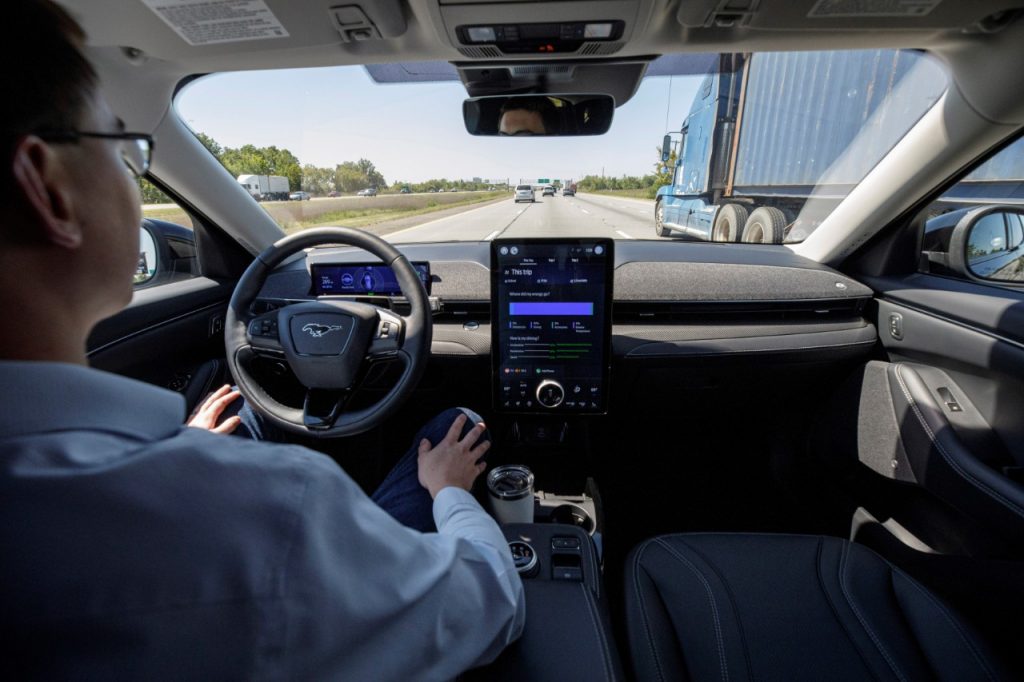
Ford is adding hands-free lane changing and other features to the next generation of its BlueCruise advanced driver assistance system (ADAS), the company announced Sept. 8.
Ford BlueCruise, formerly known as Active Drive Assist, allows for hands-free driving on prequalified sections of divided highways called “Hands-Free Blue Zones” that currently make up more than 130,000 miles of North American roads.
BlueCruise uses animated cluster transitions featuring text and blue lighting on the digital instrument cluster to indicate when the vehicle is in a hands-free zone, effective even for those with color blindness. Ford is using anonymized data that its customers voluntarily share to improve BlueCruise by refining visuals, sensing and steering for more natural performance.
Beginning this fall with the 2023 Mustang Mach-E, Ford’s BlueCruise 1.2 and the Lincoln ActiveGlide 1.2 system will receive three new ADAS features:
- The Lane Change Assist feature will perform a hands-free lane change when requested by the driver tapping the turn signal. It can even suggest if a lane change would be beneficial when following slow-moving traffic.
- The Predictive Speed Assist feature automatically and smoothly adjusts the vehicle’s speed as drivers approach a sharp curve. It will help signal the driver ahead of time when a speed change is about to occur, so they understand why the vehicle is slowing.
- The In-Lane Repositioning feature keeps the vehicle in its lane while subtly shifting the vehicle’s position away from vehicles in adjacent lanes. The goal of this features is make the hands-free highway driving experience feel more natural, and may prove especially helpful when next to bigger vehicles such as semis.
“We are investing in our ADAS team to constantly improve BlueCruise and ActiveGlide for our customers,” Doug Field, chief electric vehicle and digital systems officer for the Ford Model e, said in a statement. “The latest improvements allow customers to command lane changes using just a turn signal, and make hands-free driving feel more human-like by smoothly slowing down for turns, and giving more room to large vehicles in neighboring lanes. These improvements are just the beginning of a constant journey toward improving safety and, in the future, giving customers valuable time back.”
More than 75,000 Ford and Lincoln owners have enrolled in BlueCruise and ActiveGlide, which launched in July 2021. They have accumulated more than 16 million hands-free driving miles through the end of August.
In July, Ford noted BlueCruise adoption is growing quickly, with nearly 15,000 2021 F-150 and Mach-E customers have received the technology through Ford Power-Up software updates and 35,000 more in process. The company estimated about 66,500 customers are now using BlueCruise,
“We are rapidly increasing the number of digital vehicles on the road with new services that create ‘always-on’ customer relationships with great software experiences,” Ford CEO Jim Farley said in a statement. “BlueCruise is a great example as customers have driven more than 10 million miles hands-free in just one year since we launched the capability and delivered it with a Ford Power-Up software update.”
BlueCruise faces a number of competitors. Tesla added automatic lane changing to its Autopilot system in 2019, and GM included the feature in its Super Cruise ADAS starting in 2021.

